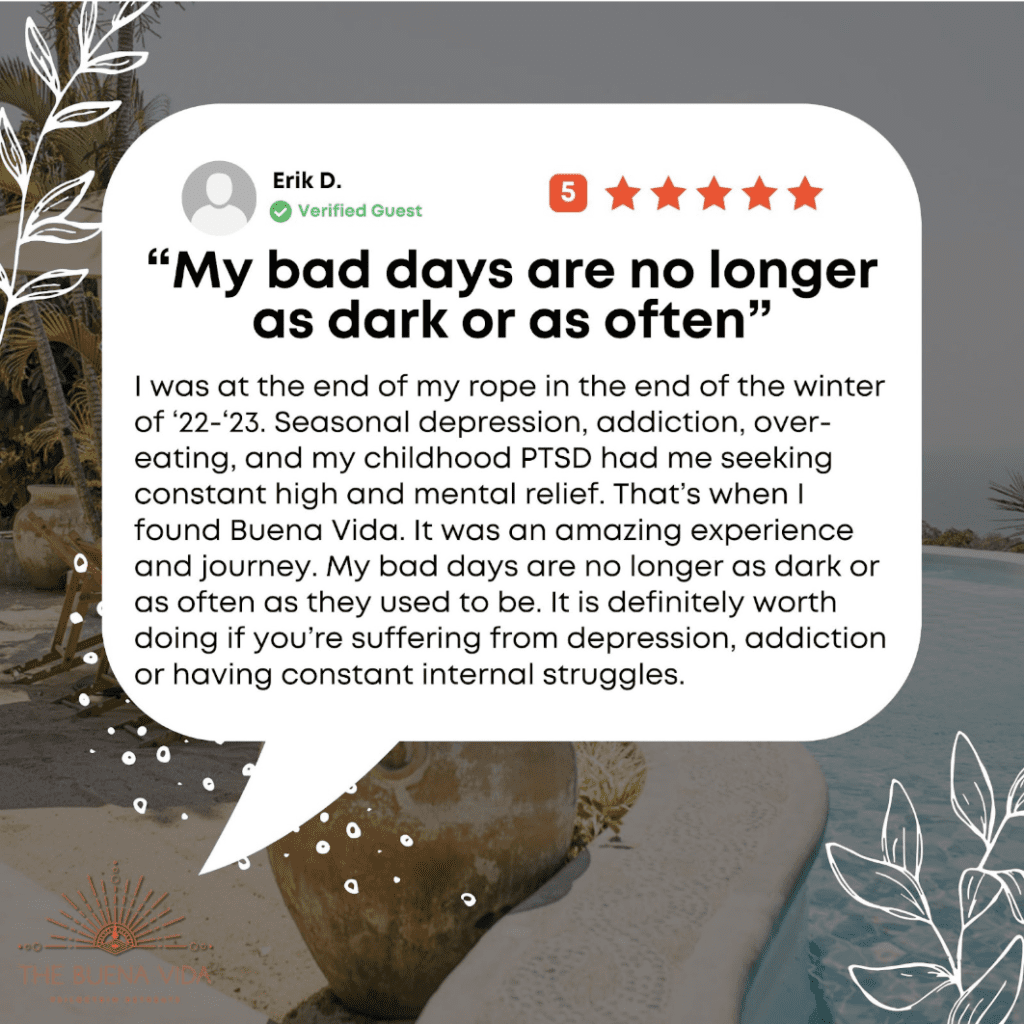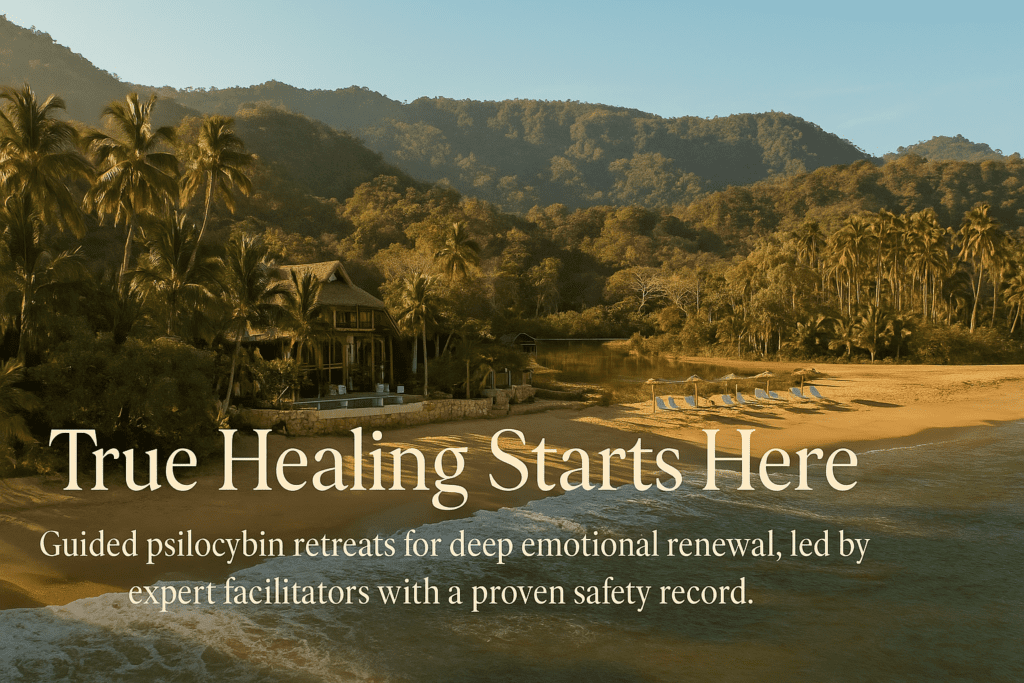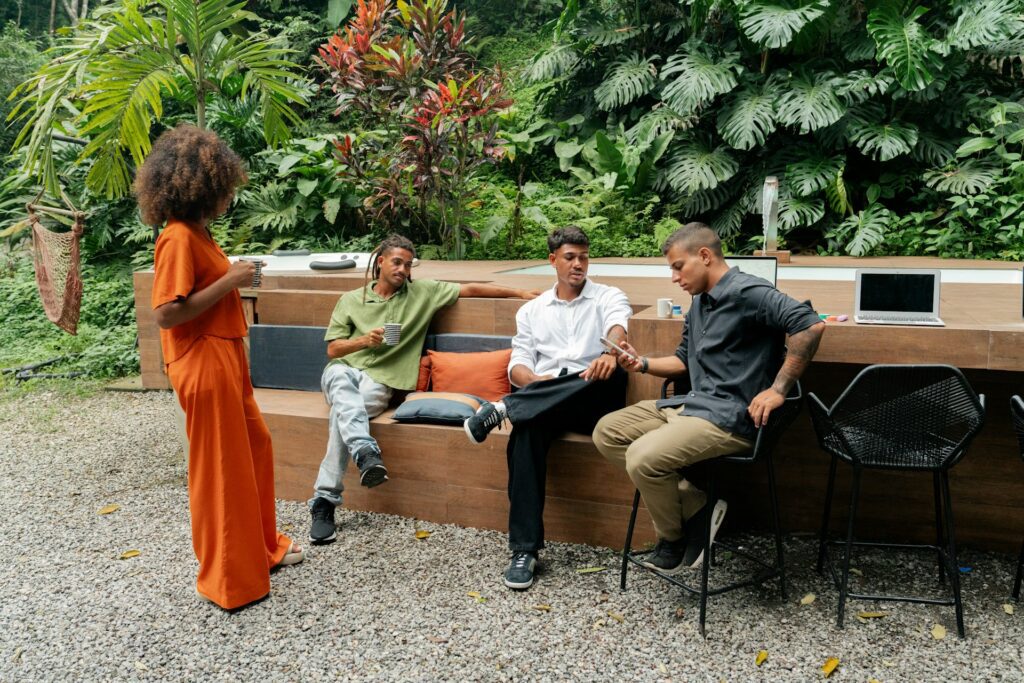Research shows psilocybin may rewire trauma-locked pathways, ease fear, and support healing by boosting neuroplasticity. But without the right setting, even powerful tools can backfire. Intentional use, guidance, and integration make all the difference.
At The Buena Vida, we’ve witnessed firsthand how psilocybin can soften the edges of suffering, unlocking space for peace, perspective, and profound transformation. But healing PTSD is rarely linear—and certainly not a simple fix.
Without the right container, even the most promising tools can falter. That’s why safe settings, trauma-informed care, and ongoing integration are non-negotiables in our work.
Considering psychedelic therapy for trauma healing? Here’s what you need to know before diving in.
What Is PTSD and Why Is It So Hard to Treat?
Post-traumatic stress disorder (PTSD) isn’t just about what happened to someone—it’s about what keeps happening inside them long after the trauma has passed. It lives in the nervous system, disrupting sleep, hijacking emotions, and triggering fear responses at even the slightest reminder of the past.
For many of our guests, PTSD looks like this:
- Flashbacks that pull them out of the present
- Constant hypervigilance, like they’re always waiting for the next bad thing
- Emotional shutdown or numbness—because feeling anything at all feels dangerous
One of the hardest parts of PTSD is that it disrupts the brain’s ability to extinguish fear. The hippocampus—the region responsible for processing memory and learning safety—is often physically smaller in people with PTSD. That shrinkage means trauma memories stay active and loud, while the ability to self-soothe fades.
Standard Treatments for PTSD—and Their Limits
We honor every healing path. But for many, the usual clinical approaches haven’t delivered lasting relief.
Here’s what’s most commonly offered:
- SSRIs (like Zoloft or Prozac): Can blunt symptoms, but often come with side effects and don’t address root causes.
- Cognitive Behavioral Therapy (CBT): Helps reframe thought patterns, but can feel overly cerebral for trauma stored in the body.
- EMDR (Eye Movement Desensitization and Reprocessing): Powerful for some, but not always accessible or effective for complex trauma.
We’ve seen guests come to us after trying everything—meds, talk therapy, self-help books—still feeling stuck. That’s where psilocybin offers a new path forward. Not as a replacement, but as a reset. One that works not just through words or logic, but through direct experience, deep inside the self.
How Psilocybin Works on the Brain (And Why That Matters for PTSD)
If PTSD traps the brain in fear loops, psilocybin helps cut new paths through that mental maze. It works less like a band-aid and more like a catalyst—reconnecting parts of the brain that trauma separated, and softening the grip of past pain.
The Science of Fear Extinction
One of the biggest breakthroughs in psilocybin research is its impact on fear extinction—the brain’s ability to learn that something once dangerous is now safe.
Trauma often freezes the nervous system in place. The hippocampus, responsible for processing memory and safety, can shrink under chronic stress. Psilocybin seems to reverse that damage.
In studies with mice:
- A single dose of psilocybin increased dendritic complexity—meaning brain cells grew more branches to connect and communicate.
- It boosted neuroplasticity, the brain’s ability to change, adapt, and form new patterns.
- Treated mice showed faster emotional recovery and less fear-based behavior over time.
It’s as if the brain remembers how to heal again.
Modulating the Default Mode Network (DMN)
The Default Mode Network is the brain’s internal narrator. It runs when we’re ruminating, judging ourselves, or reliving memories on loop.
In PTSD, this network tends to be hyperactive—keeping trauma at the forefront of the mind. Psilocybin temporarily disrupts this pattern.
Here’s what that does:
- Interrupts the “I am broken” narrative that PTSD often reinforces
- Makes space for new insights, self-compassion, and calm
- Allows deeply rooted beliefs to be questioned, softened, or even released
When we quiet that inner monologue, we often find something wiser underneath.
Ego Dissolution & Emotional Rewiring
In our retreats, we often hear guests describe their experience as “melting into something bigger.” That’s what scientists call ego dissolution—a temporary softening of the mental walls we build to stay safe.
This doesn’t mean losing control. It means seeing yourself without the usual filters of shame, fear, or judgment.
One guest, after a deeply emotional session, told us:
“I finally saw my childhood for what it was—not my fault. I didn’t just understand it. I felt it. And that changed everything.”
This emotional rewiring doesn’t erase the past. But it offers a new lens. One that holds trauma in context, not in command.
Will Mushrooms Make You Relive Your Trauma—or Help You Heal It?

This is one of the most important questions we get from potential guests. The truth? Psilocybin can take you deep—but whether that’s healing or harmful depends on what’s waiting for you at the surface, and who’s there to help you navigate it.
Catharsis vs. Overwhelm
Yes, mushrooms can bring up long-buried trauma. We’ve seen guests remember traumatic events they hadn’t thought about in decades. But this isn’t always gentle.
Without proper support, those breakthroughs can turn into emotional flooding—tears that never stop, truths that feel too big to hold. We’ve worked with guests who came to us after past psychedelic experiences left them feeling more cracked open than whole.
That’s why integration therapy—before and after—is essential. Healing isn’t just about what you feel in ceremony. It’s about what you do with it after.
Key components of safe psychedelic healing:
- Preparation that helps you meet the unknown with curiosity, not fear
- Emotional anchors like breathwork, grounding techniques, and trauma-informed guidance
- Structured integration, so insights turn into action—not overwhelm
Set, Setting & Safeguards Matter
Even with the “right” dose, a trip can go sideways if you’re not held in the right container. Solo journeys, especially for those with trauma, carry real risk.
Why? Because psilocybin doesn’t just show you light. It can show you shadows too.
That’s why we build the experience around safety:
- Our facilitators are trained to recognize trauma responses in real time
- Guests are never left alone during deep work
- Integration isn’t an afterthought—it’s built into our retreat model, from start to finish
What If You’re on Meds Like Quetiapine?
This is a must-ask question—and a common concern.
Certain medications, especially antipsychotics like quetiapine, can dull or dangerously clash with psilocybin. We’ve heard stories of panic attacks, confusion, even long-term side effects when people skipped the medical screening.
That’s why we never skip this step.
At The Buena Vida, every guest undergoes a detailed intake process. We work with licensed professionals to assess mental health history, medications, and contraindications. If you’re not a match for this work right now—we’ll tell you, and we’ll help guide you to something that’s safer for you.
Because no experience is worth the risk of destabilization. Safety isn’t just our priority—it’s our foundation.
Real People, Real Stories: What Healing (and Harm) Look Like
We’ve guided over a thousand guests at The Buena Vida, and if there’s one thing we’ve learned, it’s this: every journey is different.
Some arrive seeking a shift and leave feeling reborn. Others come face-to-face with truths they weren’t expecting. That’s why preparation, support, and care are non-negotiable.
Let’s look at what this work can look like—on both sides of the coin.
“The Snow Globe Shook” – A Breakthrough
One guest described her journey like this:
“It was like my mind was a snow globe—trauma had frozen everything in place. Psilocybin shook it. Suddenly, I could see things from a distance, not just through the storm.”
She’d spent years in therapy, circling the same pain. But during one session, held in ceremony, something softened. She didn’t relive the trauma—she saw it differently. Less like a threat, more like a chapter.
This is what we mean by “fear extinction.” When the brain gets a chance to rewire, old triggers lose their charge. That’s where real healing begins.
“The Trip Took Me” – A Cautionary Tale
Not all journeys go smoothly. We’ve spoken with individuals who took mushrooms alone, hoping for clarity—and instead were swept into a spiral of panic and confusion.
One woman had the right intentions, but no support. No guide. No preparation.
Her experience quickly became chaotic. Visions, racing thoughts, an overwhelming sense of doom. For weeks afterward, she struggled to make sense of it—and it took her months to ground again.
This isn’t a scare tactic. It’s a reality check. Psilocybin isn’t inherently healing. It’s the container that makes it transformative.
Key reasons DIY psychedelic journeys can backfire:
- No medical screening for contraindications
- No one present to help regulate or reframe distressing content
- No integration process to turn insight into growth
- No trauma-informed safety net when emotional overwhelm hits
The Power of a Guided Memory Walk
One of our most profound experiences came from a guest who, during a ceremony, accessed childhood memories she didn’t know were there. She cried through most of the night. But she was held. Not just by us, but by herself—for the first time in years.
She told us later:
“That night cracked me open. But the weeks after put me back together. And for once, it felt like me doing the building.”
Her healing didn’t happen in one night. It happened in the integration: the journaling, the group calls, the silent walks back home with a new perspective.
Why Integration Is Where the Real Healing Happens
The truth is, the ceremony isn’t the whole journey. It’s the spark. What matters just as much—if not more—is what you do after the fire is lit.
We tell every guest this before they even arrive: The real medicine starts after the mushrooms wear off.
Neuroscience of Long-Term Change
When psilocybin opens neural pathways and boosts neuroplasticity, the brain becomes more flexible—more open to new patterns and less tied to trauma-based responses.
But here’s the catch: those new pathways need reinforcement.
Without action, the brain will naturally slip back into the same survival circuits it’s always used.
Think of it like physical therapy after an injury:
- The session is the reset.
- Integration is the training that helps the new patterns stick.
- Healing isn’t just about release—it’s about rebuilding.
What Integration Support Looks Like
With us, integration isn’t optional. It’s woven into everything we do—before, during, and especially after.
We’ve seen that breakthroughs only become life-changing when they’re nurtured in real life. That means taking what was revealed in ceremony and weaving it into your day-to-day self.
Key components of effective integration:
- Peer support: Sharing your process in safe, non-judgmental circles
- Journaling: Capturing insights, patterns, and emotional waves
- Therapist guidance: Especially with trauma, working with a skilled guide can turn confusion into clarity
- Post-retreat coaching: Our team supports guests weeks (and even months) afterward to make sure the work sticks
Can You Heal Without a Psychedelic?
Absolutely. Psychedelics aren’t the only path—and they’re not the right fit for everyone.
Some people access deep healing through:
- EMDR: Proven effective for PTSD and trauma processing
- Breathwork & somatic experiencing: Helps release trauma stored in the body
- Talk therapy & shadow work: When held with care, these modalities go deep
Psilocybin is powerful—but it’s just a tool. It won’t do the work for you. What it can do is show you what’s possible, pull back the curtain, and open the door. The walking? That’s up to you.
Are There Other Drugs Being Tested for PTSD?
Yes—and it’s an exciting time in mental health. For the first time in decades, new doors are opening for those who haven’t found relief through traditional medications. Psilocybin is just one of several emerging therapies being explored for trauma and PTSD.
Let’s break down what’s out there—and how mushrooms fit into the picture.
MDMA-Assisted Therapy
MDMA is currently in advanced clinical trials, spearheaded by MAPS (Multidisciplinary Association for Psychedelic Studies). It’s showing remarkable results, particularly when combined with psychotherapy.
MDMA can:
- Lower fear responses in the brain
- Increase trust and connection
- Help people speak about trauma without being retraumatized
FDA approval may be on the horizon—and we’re watching it closely.
Ketamine
Ketamine is already being used off-label for treatment-resistant depression and PTSD. It’s fast-acting and legal in many clinical settings.
However, its effects can be short-lived, and some people require regular infusions to maintain stability. It’s more of a bridge than a full healing path for many.
SSRIs & SNRIs
These are still the go-to prescriptions in mainstream psychiatry.
They can help manage symptoms, especially for anxiety and depression—but:
- They don’t address the root of trauma
- Many users report emotional numbness or flatness
- They must be taken daily, often for years
How Psilocybin Differs
What sets psilocybin apart isn’t just how it works—but how often it’s used.
Key differences:
- Non-daily: One or two sessions can lead to significant changes
- Deep and episodic: Psilocybin isn’t about symptom suppression—it’s about pattern disruption
- Facilitates insight: Rather than masking pain, it helps people understand and reframe it
This is why, when used intentionally and supported properly, psilocybin can become a turning point—not just a treatment. Not everyone needs frequent medication. Some need a new perspective.
What If I Unlock Memories I Can’t Handle?
It’s possible. Psilocybin can bring repressed experiences to the surface. That’s why integration therapy is not optional—it’s the bridge between insight and emotional safety.
We never open the door without making sure you’re supported on the other side.
Set, setting, guide, and dose are everything.
At The Buena Vida, we create a trauma-informed space, designed specifically to minimize the risk of emotional overwhelm. You’re never left alone. You’re never asked to “figure it out” on your own.
How to Safely Explore Psilocybin for PTSD
If you’re considering working with psilocybin to heal trauma, the most important decision you’ll make isn’t whether to take it—it’s how you take it.
This work goes far beyond just “having a trip.” To be healing, it has to be held. You need the right setting, skilled support, and a structure that protects your emotional safety at every step.
Key Steps to a Safe and Transformational Experience:
- Choose a legal, guided retreat. Look for programs that operate in countries where psilocybin is permitted and have trauma-informed facilitators on staff.
- Medical screening is non-negotiable. If you’re on medications or have a complex mental health history, professional evaluation is essential.
- Never go it alone. Self-administering mushrooms, especially with PTSD, can be destabilizing or dangerous.
- Prep and integrate. Healing begins long before the ceremony—and continues long after. Choose a program that supports both.
- Assess your emotional ecosystem. Do you have access to a therapist? A trusted community? Safe spaces to process? These are just as important as the ceremony itself.
This is sacred work—and it requires sacred structure. When all the pieces are in place, psilocybin can help you reconnect with the parts of yourself that trauma taught you to bury.
Psilocybin Isn’t a Shortcut—It’s a Catalyst

Healing from PTSD is some of the bravest work a person can do. It asks everything of you—your honesty, your courage, your willingness to feel what you once had to suppress just to survive. And while psilocybin isn’t a shortcut through that process, it can be a powerful catalyst within it.
We’ve watched guests come in feeling broken, stuck, or numb—and leave with softened hearts, new language for their pain, and a spark of something that felt long lost: hope.
But let’s be clear: The trip doesn’t fix you. It shows you what needs fixing.
The healing happens in what comes next—in the journaling, the therapy, the decisions you make when no one’s watching. Psilocybin doesn’t do the work for you. It opens the door. If you’re supported, ready, and grounded, that doorway can change your life.
Curious about a guided, trauma-informed psilocybin experience?
1. Book a Retreat Ready to dive in? Apply now to join one of our upcoming psilocybin retreats, where trauma-informed care, community, and deep transformation are at the heart of everything we do.
2. Place a Future Retreat Deposit Not quite ready to pick your dates? Save your spot with a fully transferable deposit. You’ll also receive VIP early access to new retreat dates, first notice on openings, and a free personal call with our founder, Amanda Schendel.
3. Attend Our Free Webinar Still gathering information? Watch our “What Happens at a Retreat” webinar, hosted by Amanda. Choose a time that fits your schedule and learn what a psilocybin retreat really looks and feels like—no pressure, just insight.


